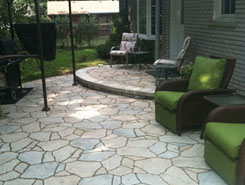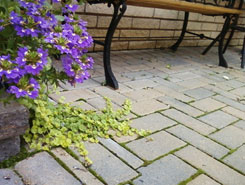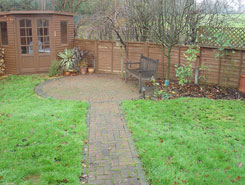Seasonal Interlock Pavement Maintenance

Paver Bed Preparation
If excavation, subsoil and base preparation are not performed correctly, then the property owner can look forward to a continuing struggle with proper drainage and leveling of the pavers. Up to 70% of the total investment in new interlocking pavement is underneath the pavers. 100% of the appearance and durability of your new patio or driveway depends on that investment.
Your contractor must determine the type of soil present and its characteristics regarding cohesion, moisture content and particle sizes. The most common – and least desirable – type of soil in North America is fine-grained clay, which requires proper drainage and compaction to form a subgrade that supports the base material pavers. Compaction prevents settling, ruts and movement due to seasonal temperature swings.
Most subgrades benefit from a geotextile material being installed before the final base aggregate. The geotextile prevents moisture transferring to the base, which would reduce its load bearing capacity.
Spring Cleaning of Interlock Pavers

- Check for damaged or displaced pavers and determine if they should be replaced.
- Check if joint sand is low or missing between pavers.
- Look for a white coating on pavers when they are dry, which indicates efflorescence.
If there is moss, lichen or weed growth on the pavers, treat these first with an appropriate weed killer, which may take a few days to a week to do its job. Once the growth is dead, use a power washer to remove the dead growth, stains and any other dirt from the pavers’ surface. If efflorescence is visible after the pavers dry, wet them again and apply Techniseal Paver Prep efflorescence cleaner followed by a thorough rinse.
Once the cleaning is done, spread joint sand across the pavers and use a broom to sweep it between the joints and remove excess sand.
Summer Maintenance
When the weather turns dry, power wash your pavers once again and apply a sealant to protect pavers from fall and winter rains, and reduce moss buildup. Often, this maintenance step is best handled by professionals familiar with use of the most effective proprietary cleaners and sealants available. Especially as fall approaches, keep your pavers clear of grass clippings, leaves and other debris.
Winter Preparation

Most pavers will not be damaged by snowplows or snow blowers unless the pavers have a raised surface. With the latter, more care must be taken to ensure the pavers are not scratched or otherwise damaged. If pavers become icy, use sand only as a traction material. Ice melt chemicals will damage the pavers over time.
Enjoy Your Interlocking Pavement All Year
Severe fluctuations in the Canadian climate put any pavement to the test. With correct installation techniques and annual maintenance, , an interlocking cement paver patio or driveway should remain beautiful for decades to come.
Patio Stones with Moss courtesy of Amy Gaertner
Cold and Wet courtesy of Andrew Fogg